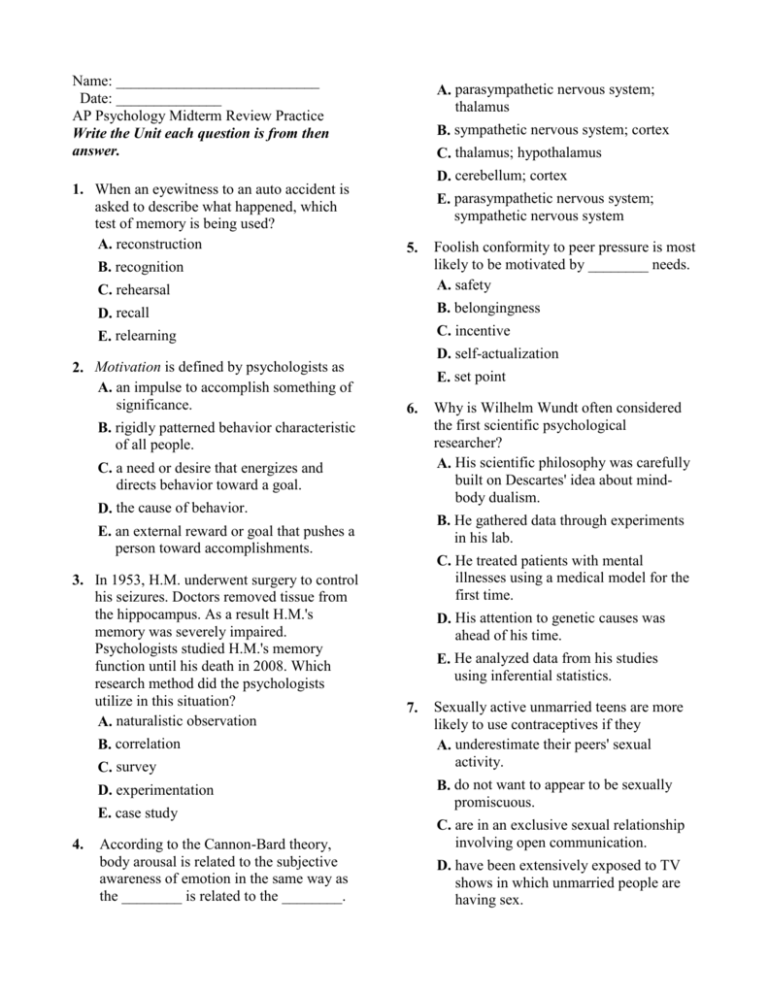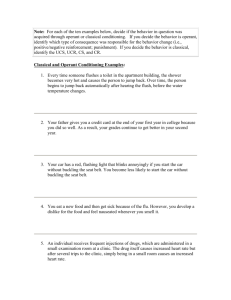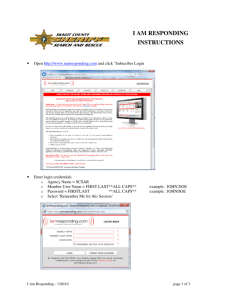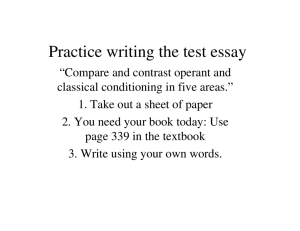AP Psych Midterm Practice Questions 2013
advertisement

Name: ___________________________ Date: ______________ AP Psychology Midterm Review Practice Write the Unit each question is from then answer. 1. When an eyewitness to an auto accident is asked to describe what happened, which test of memory is being used? A. reconstruction A. parasympathetic nervous system; thalamus B. sympathetic nervous system; cortex C. thalamus; hypothalamus D. cerebellum; cortex E. parasympathetic nervous system; sympathetic nervous system 5. B. recognition C. rehearsal B. belongingness D. recall E. relearning 2. Motivation is defined by psychologists as A. an impulse to accomplish something of significance. C. incentive D. self-actualization E. set point 6. B. rigidly patterned behavior characteristic of all people. C. a need or desire that energizes and directs behavior toward a goal. D. the cause of behavior. B. correlation C. survey D. experimentation E. case study 4. According to the Cannon-Bard theory, body arousal is related to the subjective awareness of emotion in the same way as the ________ is related to the ________. Why is Wilhelm Wundt often considered the first scientific psychological researcher? A. His scientific philosophy was carefully built on Descartes' idea about mindbody dualism. B. He gathered data through experiments in his lab. E. an external reward or goal that pushes a person toward accomplishments. 3. In 1953, H.M. underwent surgery to control his seizures. Doctors removed tissue from the hippocampus. As a result H.M.'s memory was severely impaired. Psychologists studied H.M.'s memory function until his death in 2008. Which research method did the psychologists utilize in this situation? A. naturalistic observation Foolish conformity to peer pressure is most likely to be motivated by ________ needs. A. safety C. He treated patients with mental illnesses using a medical model for the first time. D. His attention to genetic causes was ahead of his time. E. He analyzed data from his studies using inferential statistics. 7. Sexually active unmarried teens are more likely to use contraceptives if they A. underestimate their peers' sexual activity. B. do not want to appear to be sexually promiscuous. C. are in an exclusive sexual relationship involving open communication. D. have been extensively exposed to TV shows in which unmarried people are having sex. E. previously made written commitments to remain celibate until marriage. 8. Cognitive psychologists are most directly concerned with the study of A. emotion. B. genetics. C. the unconscious. D. brain chemistry. E. thinking. 9. Retroactive interference involves the disruption of A. automatic processing. B. iconic memory. C. memory retrieval. D. semantic encoding. E. echoic memory. 10. Molecular behavior geneticists seek links between __________ and specific disorders. A. chromosomes B. proteins C. genes D. environment E. behavior 11. Split-brain patients have had their ________ surgically cut. A. hippocampus B. limbic system C. corpus callosum D. sensory cortex E. reticular formation 12. Rochelle is extremely thin but is convinced that she is too fat. Rochelle's certainty is best explained by which of the following concepts? A. framing B. availability heuristic C. belief perseverance D. overconfidence E. representativeness heuristic 13. Which psychological perspective most directly addresses questions about the relative influences of nature and nurture? A. behavioral perspective B. humanistic perspective C. psychopharmacology D. cognitive perspective E. biopsychosocial perspective 14. The sudden comprehension of the double meaning of a humorous pun best illustrates A. the representativeness heuristic. B. belief perseverance. C. the availability heuristic. D. the framing effect. E. insight. 15. Any stimulus that, when presented after a response, strengthens the response is called a(n) A. conditioned stimulus. B. unconditioned stimulus. C. positive reinforcer. D. negative reinforcer. E. positive punishment. 16. The biopsychosocial approach provides an understanding of social-cultural influences integrated within the larger framework of A. functionalism. B. introspection. C. humanistic psychology. D. multiple levels of analysis. E. structuralism. 17. Someone trying to figure out an optical illusion is probably experiencing increased brain waves and bloodflow to which brain structure? A. left hemisphere to recognize meaningful objects and events is called A. sensory adaptation. B. thalamus C. reticular formation B. parallel processing. C. sensation. D. right hemisphere E. medulla D. perception. E. accommodation. 18. The term catharsis refers to emotional A. disturbance. B. inhibition. C. release. D. adaptation. E. stress. 19. What is the danger of labeling behaviors such as too much eating, shopping, exercise, sex, or gambling as addictions? A. It can lead to increased feelings of shame and guilt. B. No physical or emotional pain is associated with these behaviors. C. Abusers may be more likely to hide their abuse and avoid seeking help. D. Abusers are more likely to experience prejudice and discrimination. E. It can be used as an “all-purpose” excuse to explain away the behaviors. 20. As a psychologist employed by a medical school, Dr. McNerney specializes in research on the causes of stress and on the effectiveness of various techniques for coping with stress. Dr. McNerney is most likely a(n) ________ psychologist. A. educational B. behavioral C. forensic D. health E. humanistic 21. The process by which we select, organize, and interpret sensory information in order 22. Which of the following describes evidence for the brain's dual-processing ability? A. The right occipital lobe perceives stimuli from our left visual field. B. The corpus callosum allows impulses to travel between the two hemispheres. C. The brainstem keeps our heart beating while the cerebral cortex maintains awareness of the outside world. D. The amygdala shares responsibility for some basic emotions with the hypothalamus and endocrine system. E. The cerebral cortex is divided into two sets of lobes on each hemisphere. 23. Women are most likely to be sexually attracted to men who seem A. shy and reserved. B. emotionally reactive and intense. C. interested in recreational sex. D. mature and affluent. E. extraverted and dependent. 24. At the age of 22, Mrs. LaBlanc was less than 4 feet tall. Her short stature was probably influenced by the lack of a growth hormone produced by the A. pancreas. B. thyroid. C. adrenal gland. D. pituitary gland. E. myelin. 25. The World Health Organization identifies obesity as a high A. basal metabolic rate. B. body mass index. C. set point. D. unit bias. E. glucose level. 26. Research suggests that an important factor contributing to drug abuse by youth and young adults is A. having a parent who suffers from narcolepsy. B. feeling that one's life is meaningless. C. abnormally high levels of the brain chemical NPY. D. sleep apnea. E. disturbing latent content in dreams. 27. As drug users experience neuroadaptation, they demonstrate signs of A. dissociation. B. narcolepsy. C. tolerance. D. hallucinations. E. NREM. 28. Deep sleep appears to play an important role in A. narcolepsy. B. sleep apnea. C. paradoxical sleep. D. environment. E. natural selection. 30. In trying to solve a potentially complicated problem quickly, we are most likely to rely on A. prototypes. B. heuristics. C. phonemes. D. algorithms. E. framing. 31. Which of the following is true of negative reinforcement and punishment? A. Negative reinforcers increase the rate of operant responding; punishments decrease the rate of operant responding. B. Negative reinforcers decrease the rate of operant responding; punishments increase the rate of operant responding. C. Negative reinforcers decrease the rate of operant responding; punishments decrease the rate of operant responding. D. Negative reinforcers have no effect on the rate of operant responding; punishments decrease the rate of operant responding. E. Negative reinforcers decrease the rate of operant responding; punishments have no effect on the rate of operant responding. D. posthypnotic amnesia. E. physical growth. 29. If a genetic predisposition to fear darkness contributes to reproductive success, that trait will likely be passed on to subsequent generations. This best illustrates A. mutation. B. psychopathology. C. behavior genetics. 32. After looking up his friend's phone number, Alex was able to remember it only long enough to dial it correctly. In this case, the telephone number was clearly stored in his ________ memory. A. echoic B. short-term C. flashbulb D. long-term E. implicit 33. In a well-known experiment, preschool children pounded and kicked a large inflated Bobo doll that an adult had just beaten on. This experiment served to illustrate the importance of A. negative reinforcement. B. operant conditioning. C. respondent behavior. D. observational learning. E. spontaneous recovery. E. the double-blind procedure. 37. The statement, “The haystack was important because the cloth ripped,” becomes easier to understand and recall when you are given the following prompt: “A parachutist.” This best illustrates the influence of A. visual encoding. B. parallel processing. C. sensory memory. D. semantic encoding. E. mnemonic devices. 34. A correlation coefficient is a measure of the A. difference between the highest and lowest scores in a distribution. B. average squared deviation of scores from a sample mean. 38. In a distribution of test scores, which measure of central tendency would likely be the most affected by a couple of extremely high scores? A. median C. direction and strength of the relationship between two variables. B. range C. mode D. statistical significance of a difference between two sample means. D. standard deviation E. mean E. frequency of scores at each level of some measure. 35. Endocrine glands secrete hormones directly into A. synaptic gaps. B. the bloodstream. C. dendrites. D. sensory neurons. E. interneurons. 36. Giving half the members of a group some purported psychological finding and the other half an opposite result is an easy way to demonstrate the impact of A. overconfidence. B. illusory correlation. C. the hindsight bias. D. random sampling. 39. Long after being bitten by a stray dog, Alonzo found that his fear of dogs seemed to have disappeared. To his surprise, however, when he was recently confronted by a stray dog, he experienced a sudden twinge of anxiety. This sudden anxiety best illustrates A. delayed reinforcement. B. latent learning. C. spontaneous recovery. D. shaping. E. discrimination. 40. Contemporary psychologists are most likely to reject which of the following as appropriate for the study of psychology? A. empiricism B. observation C. introspection D. experimentation A. quivering eye movements that enable the retina to detect continuous stimulation. E. mental activity 41. Experiencing a green afterimage of a red object is most easily explained by A. the opponent-process theory. B. the gate-control theory. C. place theory. B. process by which stimulus energies are changed into neural signals. C. diminished sensitivity to an unchanging stimulus. D. system for sensing the position and movement of individual body parts. D. the Young-Helmholtz theory. E. frequency theory. E. process of organizing and interpreting sensory information. 42. Astrid was emotionally aroused by a TV horror movie. She became extremely angry when her younger brother momentarily blocked her view of the screen. When her movie viewing was interrupted by a phone call from her boyfriend, however, she experienced unusually intense romantic feelings. Astrid's different emotional reactions to her brother and her boyfriend are best explained by the A. catharsis hypothesis. 44. Neural networks refer to A. the branching extensions of a neuron. B. interconnected clusters of neurons in the central nervous system. C. neural cables containing many axons. D. junctions between sending and receiving neurons. E. neurons that connect the central nervous system to the rest of the body. 45. Clinical psychologists specialize in A. constructing surveys. B. James-Lange theory. C. adaptation-level principle. D. two-factor theory. B. animal research. C. providing therapy to troubled people. E. Cannon-Bard theory. D. providing drugs to treat behavioral disorders. E. treating patients in clinical settings. 43. Kinesthesis refers to the Answer Key 1. 2. 3. 4. 5. 6. 7. 8. D C E B B B C E 9. C 10. C 11. C 12. C 13. E 14. E 15. C 16. D 17. D 18. C 19. E 20. D 21. D 22. C 23. D 24. D 25. B 26. B 27. C 28. E 29. E 30. B 31. A 32. B 33. D 34. C 35. B 36. C 37. D 38. E 39. C 40. C 41. A 42. D 43. D 44. B 45. C








